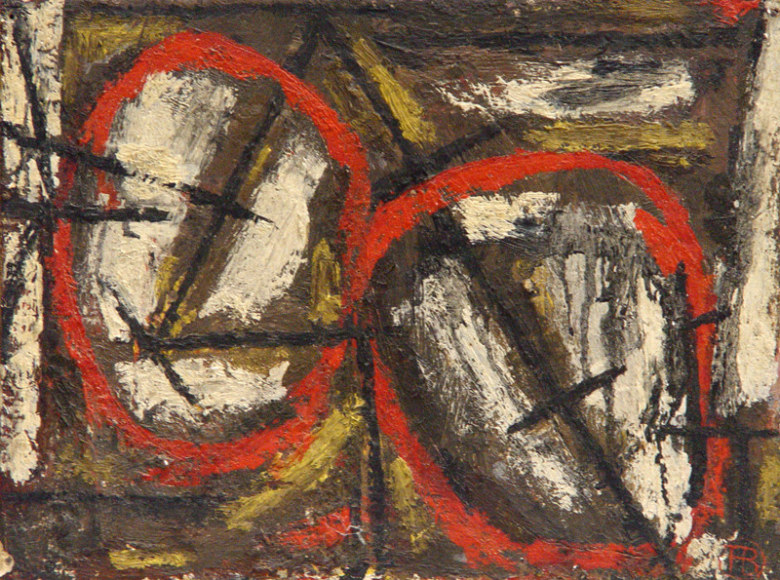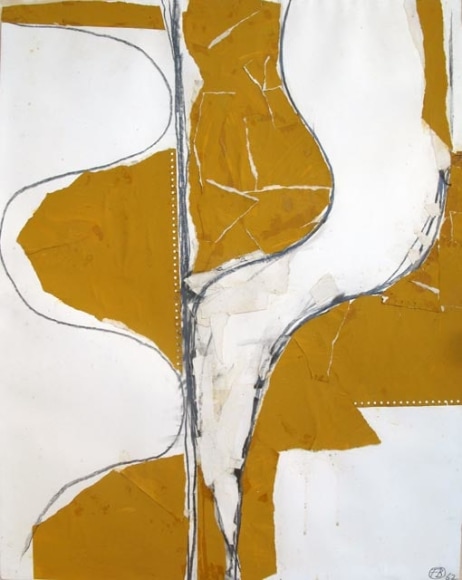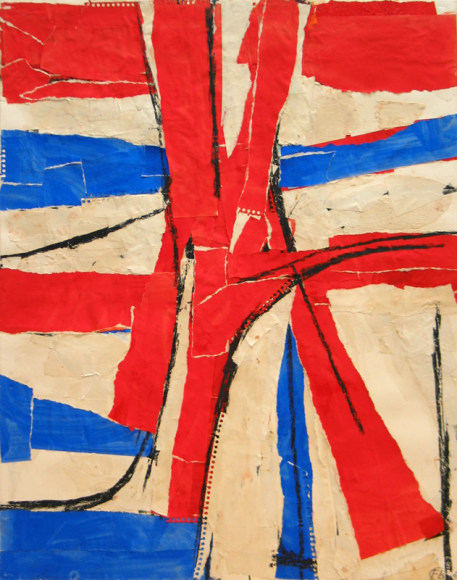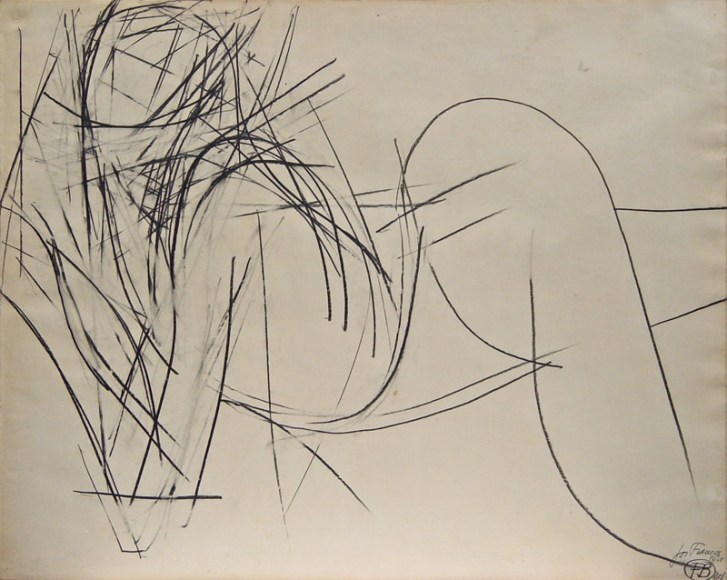Fritz Bultman

Game, 1953
Fritz Bultman was born on April 4, 1919 in New Orleans, LA. He was the second born and sole son of his parents. The family home of Fritz Bultman was the setting of Tennessee William’s play “Suddenly Last Summer”. Growing up, Fritz Bultman was surrounded by authors, musicians, and artists who spent time at the Bultman estate. The family of Fritz Bultman was well off with the father owning a funeral parlor and the mother a typical southern belle. Fritz Bultman was raised primarily by a nanny and chauffeur whom he loved dearly.
Growing up surrounded by artistic people, Fritz Bultman began his education as a painter at a very early age. Before starting high school Fritz Bultman began taking painting by a local teacher who was passionate about modern art. The real artistic education of Fritz Bultman began when the young Morris Grave’s came to visit. The information that Graves imparted influenced Fritz Bultman throughout his career. Graves had traveled extensively and introduced Fritz Bultman to artists such as Paul Gauguin, Nicolas Poussin, and Jose Clemente Orozco. In addition, Morris instructed Fritz Bultman in the art of drawing, especially birds. This introduction to form helped Fritz Bultman throughout his career. The quality of curved line taught by Graves to describe a bird’s outline influenced the shape of later abstract pieces by Fritz Bultman.
In 1935, Fritz Bultman went to Germany to study in Munich. At this time Germany was not open to avante garde artistic styles, and Fritz Bultman found himself expelled from school. Afterwards Fritz Bultman lived with Miz Hofmann, the wife of his future teacher Hans Hofmann. Fritz Bultman claimed that expulsion from school had a favorable affect on his career. During this time Fritz Bultman frequently disagreed with his father as to whether he should become an architect or painter. Fritz Bultman returned to the US to attend the New Bauhaus School in Chicago, but due to excessively strict guidelines Fritz Bultman and many others dropped out after only one year. Fritz Bultman then went on to study with his greatest influence, Hans Hofmann.
Featured works
Biography
Hans Hofmann instructed many of the abstract expressionists. His teaching style allowed students such as Fritz Bultman to learn as much from him as they did from each other. Hofmann encouraged Fritz Bultman to reach abstraction and non-objective art through practice. Despite everything that Hofmann taught Fritz Bultman, their work does not look overtly similar. This phenomenon can be explained simply that Fritz Bultman had a natural affinity for creating art. Hofmann did augment the understanding of color, line, and combining dynamic shapes in Fritz Bultman.
Fritz Bultman worked in a diverse array of mediums including painting, sculpture, collage, and drawing. While Fritz Bultman explored concepts in a wide variety of mediums, he managed to keep a continuous style throughout his works. The style of Fritz Bultman developed slowly and organically.
In his early work, the Acteon myth captivated Fritz Bultman. In this myth the hunter Acteon saw the goddess Diana naked, and she punished him by turning him into a deer and hunting him. The myth resonated with Fritz Bultman in many ways. Fritz Bultman saw it as a metaphor for the risk inherent in an artist looking for superficial attractiveness. Fritz Bultman also saw in it the reversal of sexual parts when power is lost. While these works are still abstract, the meaning behind the myth inspired Fritz Bultman to create dramatic forms.
In May 1950, a group of New York School of Abstract Expressionist painters wrote a letter to The Metropolitan Museum of Art protesting its anti-abstract bias in the selection of painters for the exhibit “American Painting Today 1950.” The letter appeared in the New York Times and the Herald Tribune. A photo of the group taken on November 24, 1950 appeared in Life magazine’s January 15, 1951 issue, captioned “Irascible Group of Advanced Artists Led Fight Against Show.”
As a member of the New York School of Abstract Expressionists, Fritz Bultman signed the historical and infamous “Irascibles” letter along with William Baziotes, James Brooks, Willem de Kooning, Jimmy Ernst, Adolph Gottlieb, Robert Motherwell, Barnett Newman, Jackson Pollock, Richard Pousette-Dart, Ad Reinhardt, Mark Rothko, Theodoros Stamos, Hedda Sterne, Clyfford Still and Bradley Walker Tomlin. Missing from the famous Life magazine photo known as “The Irascibles” were Fritz Bultman, Hans Hofmann and Weldon Kees. Unfortunately, Fritz Butman was out of the country at the time this photo was taken because the Italian government had invited the artist to study sculpture. The career of Fritz Bultman was directly affected by this experience as every other member of the group went onto great fame.
In the 1940s, Fritz Bultman enjoyed using the color red as it reminded him of visceral and zealous subjects. In the early 60s, Fritz Bultman began incorporating the color blue because of its ability to simulate atmosphere. Religion was extremely important to Fritz Bultman throughout his life. Fritz Bultman enjoyed using “universal symbols” like the cross in his works, especially sculpture. In the mid-60s, Fritz Bultman experienced a life threatening illness. This lead Fritz Bultman to explore shapes in all mediums simultaneously.
Fritz Bultman taught in New York City at the Pratt Institute and Hunter College in addition to the Fine Arts Work Center in Provincetown, Massachusetts. Fritz Bultman showed his work at the Stable Gallery, Martha Jackson Gallery, and Gallery Mayer in the late 1950s. In 1964-1965, Fritz Bultman traveled to Paris with a fellowship from Fulbright. Also, Fritz Bultman received grants from the Guggenheim Foundation in 1975 and the Art Institute of Chicago.
It is clear that Fritz Bultman had amazing talent and deserved both fame and fortune. Both critics and fellow artists praised Fritz Bultman. Robert Motherwell described Fritz Bultman as one of the most splendid, radiant, and inspired painters of [his] generation, and of them all, the one drastically and shockingly underrated. He went on to say that the work of Fritz Bultman presents a standard of sensibility, a background of the best of Modernism and a painting instinct that, if anything, is too good for the present day public. The critic Belle Krasne said “There is something elemental in all of Bultman’s canvases.” He went on to praise the passion and freedom of Fritz Bultman. In the New York Times, Stuart Preston declared that Fritz Bultman had “remarkable power of organization.”
Fritz Bultman died on July 20, 1985 in Provincetown, Massachusetts of cancer.
Sources include:
Fritz Bultman: Collages, Evan R. Firestone, Donald Windham and William U. Eiland, Georgia Museum of Art – University of Georgia, Athens, GA, 1997
Fritz Bultman: The Case of the Missing ‘Irascible’, Archives of American Art Journal, vol. 34.2, 1994, p. 11-20
Fritz Bultman: A Retrospective, April Kingsley, New Orleans Museum of Art, New Orleans, LA, 1993
Fritz Bultman, Donald Kuspit, Artforum, vol. 26.3, November 1987, p. 130-131
Opening and Closing: Fritz Bultman’s Sculpture, Arts Magazine, vol. 50.5, January 1976, p. 82-83
Fritz Bultman: Sketchbook, Donald Windham Collection, New York, NY, 1948
The essay herein is the property of SPELLMAN GALLERY and is copyrighted by SPELLMAN GALLERY, and may not be reproduced in whole or in part without written permission from SPELLMAN GALLERY, nor shown or communicated to anyone without due credit being given to SPELLMAN GALLERY.



